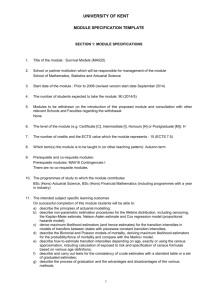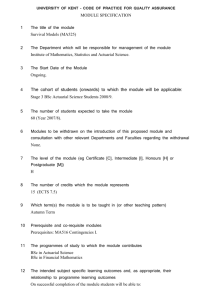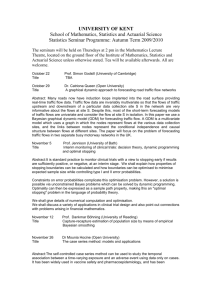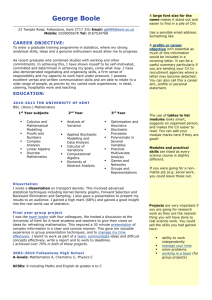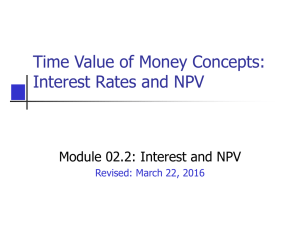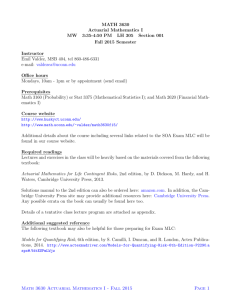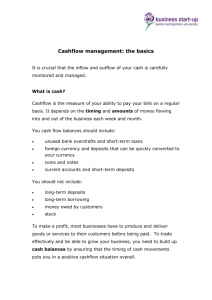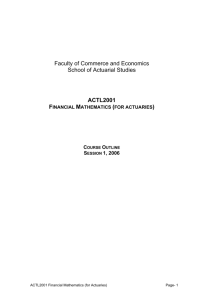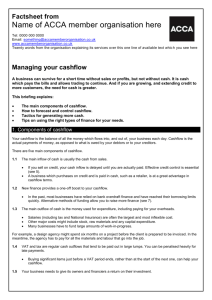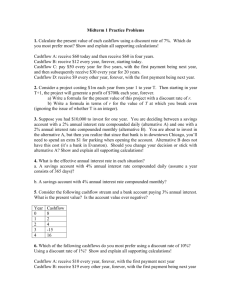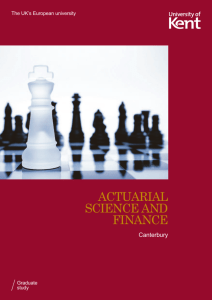section 1: module specifications
advertisement
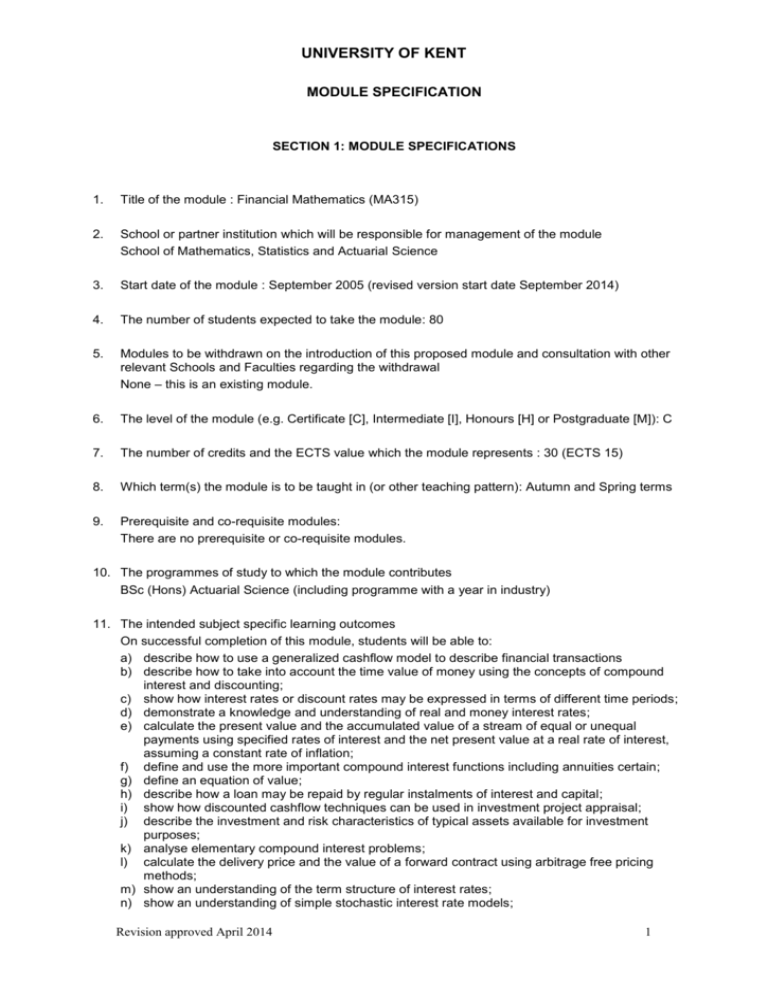
UNIVERSITY OF KENT MODULE SPECIFICATION SECTION 1: MODULE SPECIFICATIONS 1. Title of the module : Financial Mathematics (MA315) 2. School or partner institution which will be responsible for management of the module School of Mathematics, Statistics and Actuarial Science 3. Start date of the module : September 2005 (revised version start date September 2014) 4. The number of students expected to take the module: 80 5. Modules to be withdrawn on the introduction of this proposed module and consultation with other relevant Schools and Faculties regarding the withdrawal None – this is an existing module. 6. The level of the module (e.g. Certificate [C], Intermediate [I], Honours [H] or Postgraduate [M]): C 7. The number of credits and the ECTS value which the module represents : 30 (ECTS 15) 8. Which term(s) the module is to be taught in (or other teaching pattern): Autumn and Spring terms 9. Prerequisite and co-requisite modules: There are no prerequisite or co-requisite modules. 10. The programmes of study to which the module contributes BSc (Hons) Actuarial Science (including programme with a year in industry) 11. The intended subject specific learning outcomes On successful completion of this module, students will be able to: a) describe how to use a generalized cashflow model to describe financial transactions b) describe how to take into account the time value of money using the concepts of compound interest and discounting; c) show how interest rates or discount rates may be expressed in terms of different time periods; d) demonstrate a knowledge and understanding of real and money interest rates; e) calculate the present value and the accumulated value of a stream of equal or unequal payments using specified rates of interest and the net present value at a real rate of interest, assuming a constant rate of inflation; f) define and use the more important compound interest functions including annuities certain; g) define an equation of value; h) describe how a loan may be repaid by regular instalments of interest and capital; i) show how discounted cashflow techniques can be used in investment project appraisal; j) describe the investment and risk characteristics of typical assets available for investment purposes; k) analyse elementary compound interest problems; l) calculate the delivery price and the value of a forward contract using arbitrage free pricing methods; m) show an understanding of the term structure of interest rates; n) show an understanding of simple stochastic interest rate models; Revision approved April 2014 1 UNIVERSITY OF KENT o) appreciate recent developments in Financial Mathematics and the links between the theory of Financial Mathematics and their practical application. (C3) 12. The intended generic learning outcomes On successful completion of the Module, students will have developed: a) a logical mathematical approach to solving problems; b) skills in written communication; c) skills in time management and organisation; d) study skills. 13. A synopsis of the curriculum The syllabus includes the professional curriculum of the Faculty and Institute of Actuaries examination CT1. Describe how to use a generalized cashflow model to describe financial transactions Describe how to take into account the time value of money using the concepts of compound interest and discounting. Show how interest rates or discount rates may be expressed in terms of different time periods. Demonstrate a knowledge and understanding of real and money interest rates Calculate the present value and the accumulated value of a stream of equal or unequal payments using specified rates of interest and the net present value at a real rate of interest, assuming a constant rate of inflation and solve complex problems using these calculations. Define, derive and use the more important compound interest functions including annuities certain. Define an equation of value, explain the conditions under which this equation can be solved, and adjust this equation to allow for uncertain payments. Describe how a loan may be repaid by regular instalments of interest and capital and solve complex loan repayment problems. Show how discounted cashflow techniques can be used in investment project appraisal; solve complex problems using these techniques and critically evaluate these techniques. Describe the investment and risk characteristics of typical assets available for investment purposes. Analyse practical compound interest problems. Calculate the delivery price and the value of a forward contract using arbitrage free pricing methods and explain the use of hedging using these contracts Show an understanding of the term structure of interest rates; explain the factors underlying this term structure and solve practical problems involving the term structure of interest rates. Show an understanding of stochastic interest rate models; derive algebraically these models and apply these results to practical problems. This is a dynamic syllabus, changing regularly to reflect current practice. (See www.actuaries.org.uk.) 14. Indicative Reading List The material is covered by the Actuarial Education Company’s notes for Subject CT1 – Financial Mathematics. . 15. Learning and Teaching Methods, including the nature and number of contact hours and the total study hours which will be expected of students, and how these relate to achievement of the intended module learning outcomes. Number of contact hours: 72. Number of independent learning hours: 228. Total study hours: 300. The lectures contain numerous worked examples to emphasise the practical application of the theory. Students will be given exercise sheets to complete in their own time, which are intended to Revision approved April 2014 2 UNIVERSITY OF KENT reinforce the lecture material, encourage the student to read the study notes and to apply the concepts taught to practical problems. Attendance at the lectures and completion of the exercise sheets will together lead to achievement of all the learning outcomes listed in Sections 11 and 12 above. . 16. Assessment methods and how these relate to testing achievement of the intended module learning outcomes The module will be assessed by examination (80%) and coursework (20%). Coursework: This will consist of a mixture of written assessments, computer based assessments and class tests. These consist of questions and numerical problems requiring short and long answers which will test the learning outcomes as outlined in Sections 11 and 12. Examination: A 3-hour written examination in the Summer term which will consist of questions and numerical problems requiring short and long answers and which will test the learning outcomes as outlined in Sections 11 and 12. 17. Implications for learning resources, including staff, library, IT and space None – this is an existing module. 18. The School recognises and has embedded the expectations of current disability equality legislation, and supports students with a declared disability or special educational need in its teaching. Within this module we will make reasonable adjustments wherever necessary, including additional or substitute materials, teaching modes or assessment methods for students who have declared and discussed their learning support needs. Arrangements for students with declared disabilities will be made on an individual basis, in consultation with the University’s disability/dyslexia support service, and specialist support will be provided where needed. 19. Campus where module will be delivered: Canterbury SECTION 2: MODULE IS PART OF A PROGRAMME OF STUDY IN A UNIVERSITY SCHOOL Statement by the School Director of Learning and Teaching/School Director of Graduate Studies (as appropriate): "I confirm I have been consulted on the above module proposal and have given advice on the correct procedures and required content of module proposals" ................................................................ .............................................. Director of Learning and Teaching/Director of Graduate Studies (delete as applicable) Date ………………………………………………… Print Name Statement by the Head of School: "I confirm that the School has approved the introduction of the module and, where the module is proposed by School staff, will be responsible for its resourcing" ................................................................. Revision approved April 2014 .............................................. 3 UNIVERSITY OF KENT Head of School Date ……………………………………………………. Print Name Module Specification Template Last updated February 2013 Revision approved April 2014 4
